Interview by Renad Abdelhakam
هذه المقالة متوفرة باللغة العربية بالأسفل
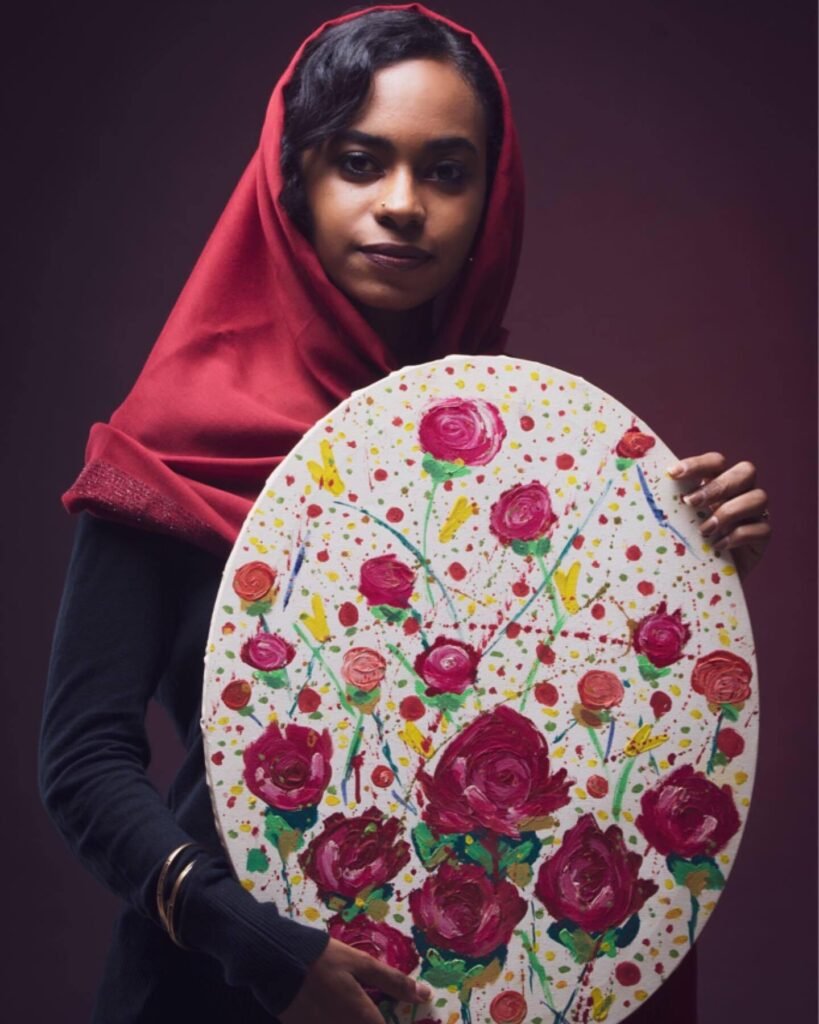
Today, we’re stepping into the creative world of Rayan Khalil, an artist whose remarkable versatility spans oil paintings, pencil sketches, watercolour portraits, and acrylic flowers. Rayan’s journey in the arts is as diverse as the mediums she masters, drawing on a rich background that includes architecture, writing, and poetry. Her work reflects her belief in the transformative power of different artistic mediums and how they can uniquely capture the essence of her subjects. In this conversation, Rayan offers insights into the sparks that kindled her passion for art and the influence of her architectural background on her creative process. As we explore Rayan’s artistic evolution and the depth of her experiences, we uncover the convoluted layers that compose her identity as an artist and the profound impact of her work.
Rayan, your work encompasses a broad range of mediums, including oil paintings, pencil sketches, watercolour portraits, and acrylic flowers. Could you tell us what initially sparked your interest in the arts and how your different experiences, including architecture, have impacted your creative process?
As an artist, I’ve always been drawn to exploring different mediums. I believe that using a specific medium can yield distinct outcomes. For instance, I’m particularly fond of the textured effect achieved through a technique called Impasto. This technique is best executed using oil paints due to their consistency and rich pigmentation.
My artistic journey began at a young age. I was fortunate to receive training from an incredible artist who introduced me to the world of gouache colours when I was just five years old. Recently, I’ve come to appreciate the idea—argued by Abdallah Pola—that having diverse skills and talents is actually beneficial for both artists and human beings in general.
At times, I’ve worn different creative hats: a writer, a poet, an architect, and, of course, an artist. These varied experiences enrich and complement one another. Interestingly, my background in architecture has significantly influenced my work as an artist, having devoted much of my adult life to architecture. Contrary to the common belief that art is purely emotional, I’ve discovered that it employs logic like architecture. In fact, you can approach the process of creating a painting much like designing a room—calculating, analysing, and arguing each artistic decision.
So, whether I’m wielding a brush or drafting blueprints, I find that these diverse creative paths converge, shaping my artistic expression.
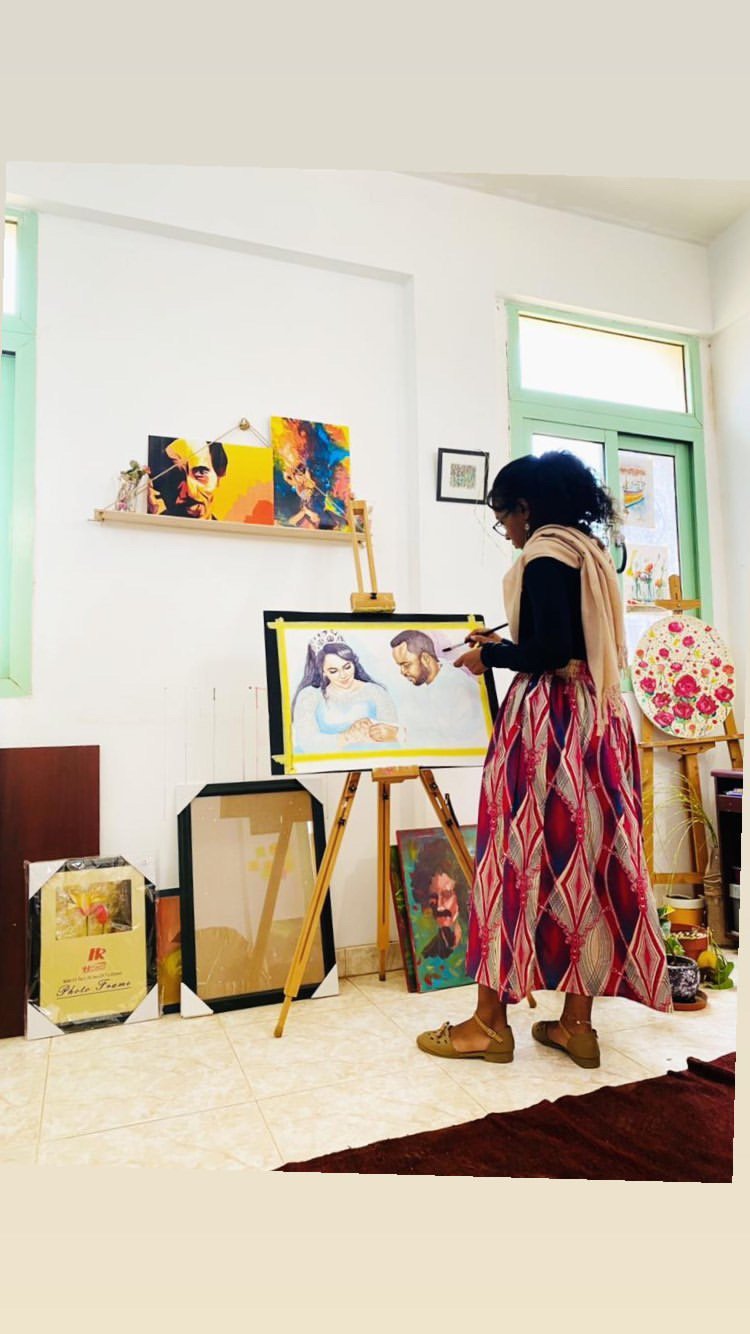
From your first acrylic on canvas that truly reflected your style to the Darwishi Calendar of 2024, your artistic journey showcases remarkable growth and experimentation. Could you elaborate more about this journey and the significant moments that have shaped your art?
Throughout my artistic journey, I’ve maintained a critical eye toward my own work. Perpetually seeking avenues for growth and refinement, I’ve strived to evolve into a well-trained artist. A pivotal turning point occurred when I joined the Khartoum Arts Center between 2017 and 2019. There, under the guidance of esteemed masters, I delved into the formal education of art. They imparted wisdom, technique, and a profound understanding of the craft.
Yet, my education extended beyond the studio walls. The great events of the 2018 Sudanese revolution left an indelible mark on my artistic sensibilities. Witnessing the resilience, passion, and collective power of people during that transformative period ignited a fire within me. It was more than inspiration; it was an instinctual connection to the human spirit—a force that infuses my creative expression.

Your diverse range of artistic works demonstrates impressive flexibility in terms of materials and concepts. Can you please guide us through your creative process, specifically how you choose a medium that complements the subject or theme you are working on? Additionally, you have mentioned the importance of having a dedicated art studio space. Can you elaborate on how your relationship with your studio affects your creativity and efficiency? How does the atmosphere of your studio contribute to your creative journey overall?
As previously mentioned, the choice of artistic medium can significantly impact the outcome of our creative endeavours. Sometimes, it’s a matter of technical suitability, while at other times, personal preference guides our selection. Personally, I find myself drawn to portraying human features using watercolours because of their transparency and delicacy. Interestingly, I perceive a parallel between the inherent qualities of watercolours and the essence of the human face.
However, beyond the medium lies the sacred realm of the artist—the studio. My belief in the importance of a dedicated studio space stems from two profound influences:
- Architectural Insight: As an architect, I embrace the notion that space has the power to define us. Just as we shape physical spaces, those spaces, in turn, shape our thoughts, emotions, and creative processes. A studio, meticulously designed and curated, becomes more than a mere workspace; it becomes a living canvas—a testament to our artistic identity. I see myself in this symbiotic relationship between artist and studio.
- Virginia Woolf’s Wisdom: In her seminal work, A Room of One’s Own, Virginia Woolf explores the concept of personal space and its impact on creativity. While she primarily discusses the need for women to have a room of their own, her insights resonate universally. A dedicated studio is not merely a physical enclosure; it is a tool of empowerment and independence. For me, the studio becomes a refuge where my voice may flourish, unaffected by societal constraints.

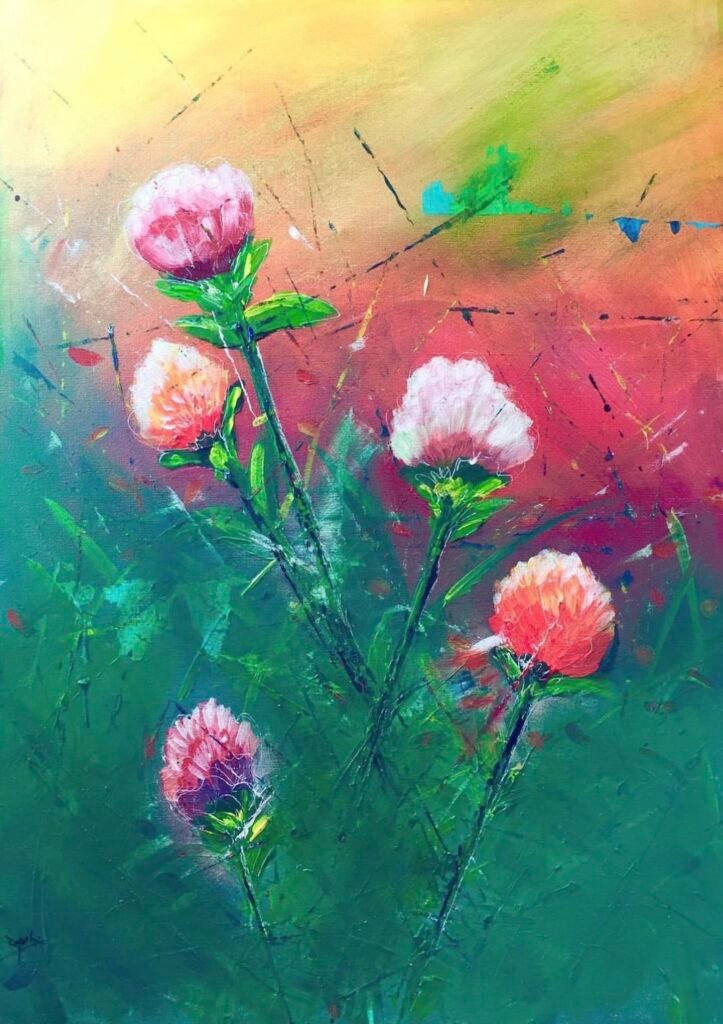
Your involvement in the Sudanese revolution through art, such as your watercolour portraits of the revolts, put you at the intersection of art and activism. How do you perceive the role of art in political and social movements? Also, what has been the most impactful response to your work in this context?
Moreover, can you tell how you choose the themes for your work and what message you intend to convey through your art about the social and cultural context of Sudan?
From the December Revolution of 2018, I learned a great deal. Although I am not the best at participating in demonstrations or delivering speeches, I knew that art was my language. I firmly believe that each of us should contribute to the revolution in our own unique way. For me, that way was through painting.
The overwhelming response I received from my art fueled my determination. I witnessed how it could ignite the revolutionary spirit within people. So, I persisted. Eventually, I became a regular artist at the monumental sit-in of 2019. The space became our canvas. Sometimes, people were drawn to the sit-in because of the art.
In my view, art played a pivotal role in the political landscape, and it continues to do so as it narrates the events of the April 2023 war. Since then, I’ve considered myself an “artivist” of sorts. Through my art, I’ve found a voice to address issues I deeply believe in, including those related to women.


Your portfolio is an excellent example of the fusion of poetry and visual art. One of your notable projects includes the Mahmoud Darwish-inspired calendar, which showcases a profound connection between literary works and your artistic expression. Looking back on your artistic journey and the diverse mediums you’ve mastered, what stands out as the most personally rewarding aspect of your work?
Looking forward, how do you envision your art evolving in the future? Are there any literary or artistic collaborations that you aspire to explore? Finally, what new challenges or projects are you looking forward to in your ongoing contribution to the Sudanese art scene?
“Painted Poems” remains one of the most captivating projects I’ve undertaken. My fascination with poetry, particularly Arabic poetry, has guided my choices. I’m drawn to poets and poetesses whose works exude a rebellious spirit—figures like Mahmoud Darweesh and Amal Dongul. Additionally, Sudanese poetry and songs, such as those by Mohammed Salim Hemmed and Mustafa Seed Ahmad, hold a special place in my heart.
As for the future, it remains an enigma. My primary goal is to evolve into a better version of myself as an artist. Currently based in Doha, I eagerly immerse myself in learning from the Arabic and Qatari art around me. Staying connected to the local atmosphere is crucial. And I try to bring that to my Sudani-inspired artwork, whether it aims to capture the current situation or any other goals. Perhaps I’ll step into the light and organise an exhibition, or maybe I’ll linger in the shadows for a while longer. The path ahead remains uncertain.
Yet, I remain open to all possibilities. Just the other day, I applied for an art teaching position. Who knows where this journey will lead!

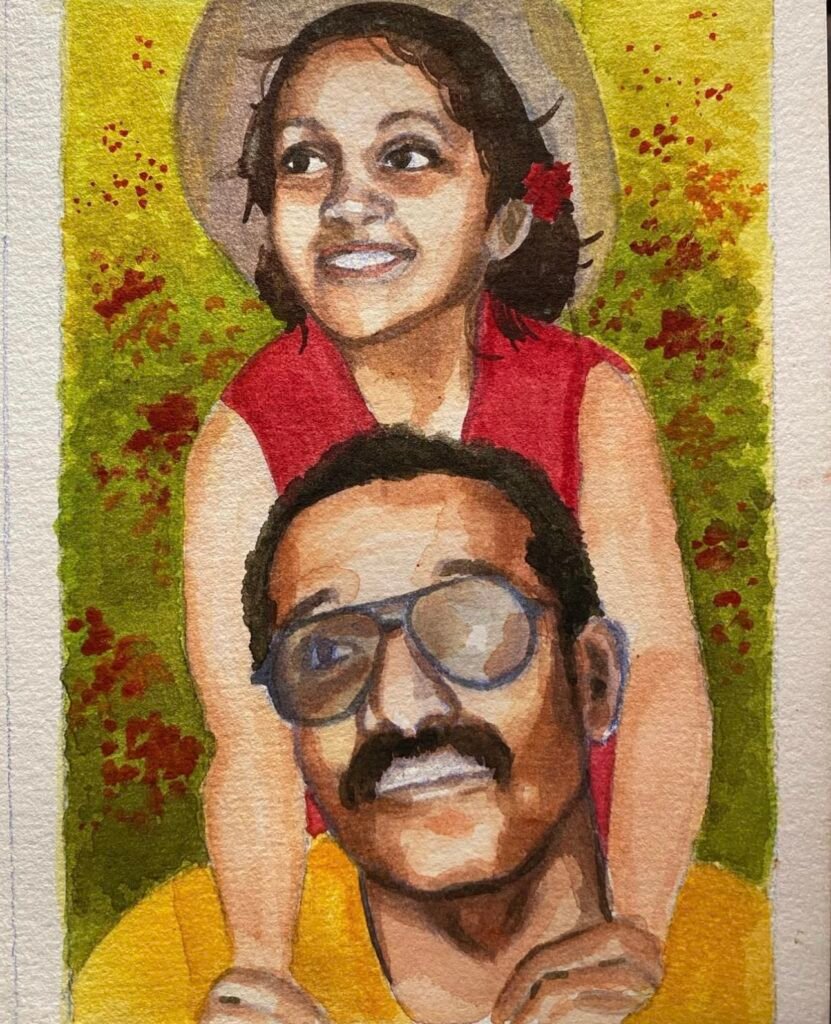
Through your Instagram, you’ve generously shared insights and tips on the business side of being an artist, which is invaluable for emerging talents. From your perspective, what are the most crucial business tips that you can offer to artists who are striving to make their mark in the industry? Could you please share one or two key pieces of advice from your own experiences that have significantly impacted your artistic career and business success?
The art business is undeniably one of the most challenging endeavours. It demands dedication and commitment akin to any other business venture. However, being a skilled artist alone does not guarantee success; one must also excel at presenting their art. Many have experienced relocations and encountered novel environments and diverse art-related situations. Therefore, these tips should specifically address this emerging reality. Personally, I continue to grapple with finding my own path:
- Understanding the New Environment: Deep comprehension of the artists’ current surroundings and mindful observation of the local art scene is essential. The audience has inevitably shifted, and adapting to this change is paramount.
- Engaging with the Artist Community: While not always easy, attendance and active participation in exhibitions, workshops, and art associations are invaluable. These connections foster growth and provide a supportive network.
- Expanding Social Media Reach: Use social media platforms to widen your audience base. Specifically, target the new region by strategically placing your content in posts and stories. Consistently employ relevant artist hashtags (e.g., #qatar_artists).
- Artistic Quality Improvement: Elevate the quality of your art, not only for external validation but also for your personal growth. The competitive landscape in your new location demands excellence.
- Embracing Change and Exploration: Be receptive to shifts and differences. Explore new mediums and styles—especially those that resonate with your new audience. Adaptability is key.
While these tips primarily cater to artists who have relocated outside Sudan, I acknowledge that the situation can be even more challenging for those who remain within the country. I personally experienced this struggle for over six months. Even if you manage to find or bring your art supplies, the pool of potential art buyers dwindles significantly due to the harsh economic conditions. However, there are bright spots like Kholal Gallery in Port Sudan. They organise exhibitions and workshops, and perhaps most importantly, they infuse you with hope!
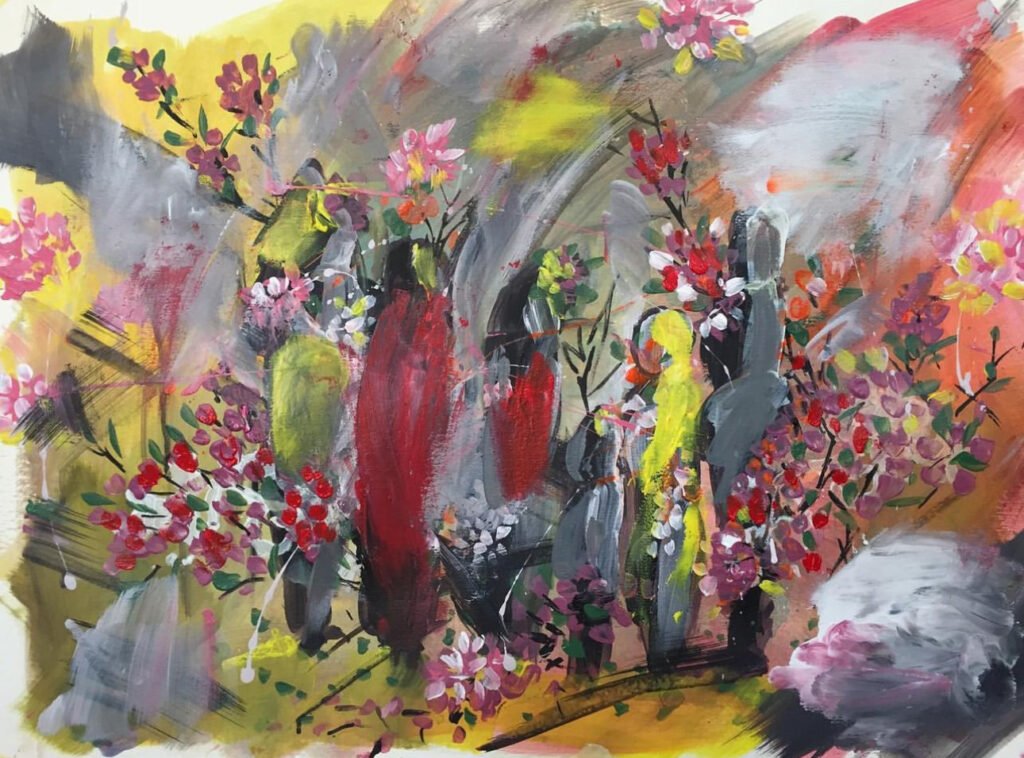
In the Seraira movie, you spoke about the unique challenges female artists face in Sudan, particularly within the conservative context of the community, while also highlighting the open nature of the art industry. Could you elaborate on these challenges and share your thoughts on how female artists can navigate them?
Additionally, what opportunities do you believe the art industry offers for women to express themselves and contribute significantly to Sudanese culture and society? How can initiatives like Bait Alnisa contribute more effectively to this opportunity?
The challenges faced by Sudanese women artists mirror the broader challenges women face. To alleviate these difficulties, empowerment is crucial. In Sudan, female artists encounter significant obstacles, particularly within the male-dominated art scene, where their contributions are often overlooked.
Becoming an artist as a woman requires overcoming substantial hurdles in our society. While some of us may be privileged compared to voiceless women, there are remarkable female artists in low-income communities, villages, and remote areas. Unfortunately, economic repression and limited access to education hinder their artistic pursuits.
Easier said than done, but to support female artists truly, we must dismantle the patriarchal system that suppresses women at all levels.
I previously expressed these sentiments during an event at Bait Alnisa in August 2022. Initiatives like Bait Alnisa play a vital role, especially for female artists. Unfortunately, there are too few programs like this that provide a platform for female artists to share their ideas and showcase their work.
While the artistic landscape remains constrained, programs like Bait Alnisa can empower everyone to find their voice. I encourage and recommend that Bait Alnisa and similar initiatives expand their reach to include those with limited access to display.
In these challenging times, many artists—both male and female—relied on art as their primary source of income but lost it due to war. Those still in Sudan need our utmost support.

Looking back on your journey as an artist, what advice has been most influential in your development? Also, what advice would you give to emerging female artists from Sudan as they navigate the challenges of the art industry?
“Always practice and never stop improving your work.” This may sound obvious, but this invaluable advice was bestowed upon me by one of the mentors at the Khartoum Art Training Center in Khartoum. Over time, I’ve come to understand that the key lies in persistent effort, regardless of the immediate results.
Today, emerging female artists face even greater challenges than before the war in Sudan. Amidst these difficulties, prioritising both physical and mental health becomes paramount. Navigating the complexities of a new world can be daunting, which is why seeking support is essential.
I encourage these artists—myself included—to believe in their abilities and recognise obstacles for what they truly are: opportunities in disguise. Self-expression becomes a healing balm, allowing them to thrive in the art industry. And if they choose to pursue art as a career, may they do so with unwavering passion and resilience.
صياغة الرؤى في وسائل متعددة: رحلة ريان خليل الفنية
مقابلة بواسطة رناد عبدالحكم

اليوم، نحن نخطو إلى عالم ريان الإبداعي، فنانة يمتد تنوعها الرائع إلى لوحات الزيت، ورسومات الرصاص، وصور الألوان المائية، وزهور الأكريليك. رحلة ريان في عالم الفنون متنوعة كما هي الوسائط التي تتقنها، حيث تستمد إلهامها من خلفية غنية تشمل الهندسة المعمارية والكتابة والشعر. تعكس أعمالها إيمانها بقوة التحول التي تمتلكها الوسائط الفنية المختلفة وكيف يمكن لها التقاط جوهر موضوعاتها بشكل فريد. في هذه المحادثة، تقدم ريان نظرة ثاقبة للشرارات التي أشعلت شغفها بالفن وتأثير خلفيتها المعمارية على عمليتها الإبداعية. بينما نستكشف تطور ريان الفني وعمق تجاربها، نكشف عن الطبقات المعقدة التي تشكل هويتها كفنانة والأثر العميق لعملها.
ريان، يشمل عملك مجموعة واسعة من الوسائط، بما في ذلك اللوحات الزيتية، والرسومات بقلم الرصاص، والبورتريهات بالألوان المائية، والزهور بالأكريليك. هل يمكنك أن تخبرينا ما الذي أثار اهتمامك في الفنون في البداية؟ وكيف أثرت تجاربك المختلفة، بما في ذلك الهندسة المعمارية، على عملية إبداعك؟
كفنانة، كنت دائمًا منجذبة إلى استكشاف الوسائط المختلفة. أعتقد أن استخدام وسيلة معينة يمكن أن يؤدي إلى نتائج مميزة. على سبيل المثال، أنا معجبة على نحو خاص بتأثير القوام الذي يتحقق من خلال تقنية تسمى “الإمباستو- Impasto”. هذه التقنية تُنفذ بشكل أفضل باستخدام الألوان الزيتية؛ بسبب تركيبتها وتشبعها الغني.
بدأت رحلتي الفنية في سن مبكرة. كنت محظوظة لتلقي تدريب من فنان رائع قد قدمني إلى عالم ألوان القواش عندما كنت في الخامسة من عمري. مؤخرا، أصبحت أقدّر الفكرة – التي طرحها عبد الله بولا – والتي تقول إن امتلاك مهارات ومواهب متنوعة يكون فعلًا مفيدًا لكل من الفنانين والبشر بشكل عام.
في بعض الأحيان، كنت أرتدي قبعات إبداعية مختلفة: كاتبة، شاعرة، مهندسة معمارية، وبالطبع، فنانة. وهذه التجارب المتنوعة تثري وتكمل بعضها بعضا. من المثير للاهتمام أن خلفيتي في الهندسة المعمارية أثرت إلى حد بعيد على عملي كفنانة، حيث كرست جزءًا كبيرًا من حياتي البالغة للهندسة المعمارية. على خلاف الاعتقاد الشائع بأن الفن هو مجرد عاطفة، فقد اكتشفت أنه يستخدم المنطق مثل الهندسة المعمارية. في الواقع، يمكنك التعامل مع عملية إنشاء لوحة تشبه إلى حد كبير تصميم الغرفة، حيث تحسب كل قرار فني وتحلله وتناقشه.
لذا، سواء كنت أستخدم فرشاة، أو أرسم مخططات، أجد أن هذه المسارات الإبداعية المتنوعة تتلاقى، وتشكل تعبيري الفني.

بدءًا من أول لوحة أكريليك التي تعكس أسلوبك حقًا، إلى تقويم درويشي لعام 2024، تُظهر رحلتك الفنية نموًا وتجارب ملحوظة. هل يمكنك توضيح المزيد عن رحلة التطور هذه واللحظات المهمة التي شكلت فنك؟
طوال رحلتي الفنية، حافظت على نظرة ناقدة تجاه أعمالي. دائمًا ما كنت أسعى إلى وسائل للنمو والتنقيح، وبذلت قصارى جهدي لأصبح فنانة مدربة بشكل جيد. حدثت نقطة تحول محورية عندما انضممت إلى مركز الخرطوم للفنون بين عامي 2017 و 2019. هناك، تحت إشراف معلمين محترمين، تعمقت في التعليم الرسمي للفنون. قدموا لي الحكمة، والتقنية، وفهمًا عميقًا للحرفة.
ومع ذلك، تجاوز تعليمي إلى ما هو أبعد من جدران الاستوديو. شكلت الأحداث العظيمة للثورة السودانية 2018 بصمة لا تمحى على مشاعري الفنية. إن رؤية مرونة الناس وشغفهم وقوتهم الجماعية خلال تلك الفترة التحولية أشعلت النار بداخلي. لقد كان أكثر من مجرد إلهام. لقد كان اتصالًا غريزيًا بالروح الإنسانية – قوة تغذي تعبيري الإبداعي.

تتنوع مجموعتك الفنية إلى حد بعيد وتظهر مرونة مذهلة فيما يتعلق بالمواد والمفاهيم. هل يمكنك إرشادنا خلال عمليتك الإبداعية، وتحديدًا كيفية اختيار وسيلة تكمل الموضوع أو الفكرة التي تعملين عليها؟ علاوة على ذلك، لقد ذكرت أهمية وجود مساحة مخصصة للعمل – استوديو. هل يمكنك توضيح كيفية تأثير علاقتك بالاستوديو الخاص بك على إبداعك وكفاءتك؟ كيف يساهم جو الاستوديو الخاص بك في رحلتك الإبداعية بشكل عام؟
كما ذُكر سابقًا، قد يؤثر اختيار وسيلة الفن إلى حد بعيد على نتائج جهودنا الإبداعية. في بعض الأحيان، يتعلق الأمر بالملاءمة التقنية، بينما في أحيان أخرى، توجهات الذوق الشخصي توجه اختيارنا. شخصيًا، أجد نفسي منجذبة إلى تصوير ملامح الإنسان باستخدام الألوان المائية؛ بسبب شفافيتها ورقة تعاملها. بشكل مثير للاهتمام، أرى توازنًا بين الصفات الجوهرية للألوان المائية وجوهر الوجه البشري.
ومع ذلك، خارج نطاق الوسيلة يقع عالم الفنان المقدس – الاستوديو. إيماني بأهمية وجود مساحة استوديو فنية مخصصة ينبع من تأثيرين عميقين:
- الرؤية المعمارية: كمهندسة معمارية، اعتنق فكرة أن الفضاء لديه القدرة على تحديد هويتنا. تمامًا كما نشكل الأماكن المادية، تشكل تلك الأماكن، بدورها، أفكارنا وعواطفنا وعملياتنا الإبداعية. يصبح استوديو، المصمم والمنظم بدقة، أكثر من مجرد مساحة عمل؛ إنه يصبح لوحة حية – شهادة على هويتنا الفنية. أرى نفسي في هذه العلاقة التكافلية بين الفنان والاستوديو.
- حكم فيرجينيا وولف: في عملها الرئيسي “غرفة خاصة بالفرد وحده”، استكشفت فيرجينيا وولف مفهوم المساحة الشخصية وتأثيرها في الإبداع. وبينما تناقش في المقام الأول حاجة النساء إلى الحصول على غرفة خاصة بهن، فإن أفكارها تلقى صدى عالميًا. الاستوديو المخصص ليس مجرد حصر جسدي؛ إنه أداة لتمكين واستقلال. بالنسبة لي، يصبح الاستوديو ملجأ حيث يزدهر صوتي، دون أن يتأثر بالقيود المجتمعية.


إن مشاركتك في الثورة السودانية من خلال الفن، مثل صورك بالألوان المائية للمشاركين في الثورة، تضعك عند تقاطع الفن والنشاط السياسي. كيف ترين دور الفن في الحركات السياسية والاجتماعية؟ وما هي أكثر ردود الفعل تأثيرًا على عملك في هذا السياق؟
بالإضافة إلى ذلك، هل يمكنك أن تخبرينا عن كيفية اختيار موضوعات عملك وما هي الرسالة التي تنوين نقلها من خلال فنك حول السياق الاجتماعي والثقافي للسودان؟
من ثورة ديسمبر 2018، تعلمت الكثير. على الرغم من أنني لست الأفضل في المشاركة في التظاهرات أو إلقاء الخطب، إلا أنني عرفت أن الفن هو لغتي. أعتقد بقوة أن كل واحد منا يجب أن يساهم في الثورة بطريقته الفريدة. بالنسبة لي، كانت تلك الطريقة من خلال الرسم.
الردود المؤثرة التي تلقيتها على فني زادت إصراري. شهدت كيف يمكن للفن أن يشعل روح الثورة داخل الناس. لذلك، واصلت باصرار. في النهاية، أصبحت فنانة منتظمة في اعتصام عام 2019. أصبح المكان لوحتنا. أحيانًا، كان الناس ينجذبون إلى الاعتصام بسبب الفن.
في رأيي، لعب الفن دورًا حاسمًا في المشهد السياسي، وما زال يفعل ذلك حيث يروي أحداث حرب أبريل 2023. منذ ذلك الحين، اعتبر نفسي “فنانة ناشطة” بطرق مختلفة. من خلال فني، وجدت صوتًا للتعبير عن قضايا أؤمن بها بشدة، بما في ذلك تلك المتعلقة بالنساء.


محفظتك الفنية هي مثال ممتاز على توازن الشعر والفن التشكيلي. أحد مشاريعك البارزة تتضمن التقويم المستوحى من اشعار محمود درويش، الذي يعرض علاقة عميقة بين الأعمال الأدبية وتعبيرك الفني. إذا نظرنا إلى الوراء في رحلتك الفنية والوسائط المتنوعة التي أتقنتها ، ما هو الجانب الأكثر مكافأة شخصيًا في عملك؟
وبالنظر إلى المستقبل، كيف تتصورين تطور فنك؟ هل هناك تعاونات أدبية أو فنية تطمحين إلى استكشافها؟ وأخيرًا، ما هي التحديات أو المشاريع الجديدة التي تتطلعين إليها في مساهمتك المستمرة في الساحة الفنية السودانية؟
لا تزال “القصائد المرسومة” واحدة من أكثر المشاريع آسرًا التي قمت بها. لقد قاد سحر الشعر ، وخاصة الشعر العربي ،اختياراتي. أنجذب إلى الشعراء والشاعرات الذين تنبع من أعمالهم روح التمرد – شخصيات مثل محمود درويش وأمل دنقل. بالإضافة إلى ذلك، يحتل الشعر والأغاني السودانية، مثل تلك التي كتبها محمد سالم حمد ومصطفى سيد أحمد، مكانة خاصة في قلبي.
أما بالنسبة للمستقبل، فإنه لغز. هدفي الرئيسي هو التطور إلى نسخة أفضل من نفسي كفنانة. حاليًا مقيمة في الدوحة، أغوص بفارغ الصبر في تعلم الفن العربي والقطري من حولي. البقاء على اتصال بالجو المحلي أمر بالغ الأهمية. وأحاول جلب ذلك إلى أعمالي المستوحاة من السودان، سواء كانت تهدف لالتقاط الوضع الحالي أو أهداف أخرى. ربما سأخرج للضوء وأنظم معرضًا، أو ربما سأظل في الظل لفترة أطول. لا يزال المسار إلى الأمام غير مؤكد.
ولكن، سأظل مفتوحة على جميع الاحتمالات. تقدمت للتو بطلب لوظيفة تدريس فنية. من يدري إلى أين سيؤدي هذا الطريق!


من خلال حسابك على إنستغرام، لقد شاركتِ بكرم رؤى ونصائح حول الجانب التجاري لكونكِ فنانة، وهو أمر لا يُقدَّر بثمن بالنسبة للمواهب الناشئة. من وجهة نظرك، ما هي أهم النصائح التجارية التي يمكنكِ تقديمها للفنانين الذين يسعون لتحقيق نجاحهم في المجال؟ هل يمكنكِ مشاركة نصيحة أو نصيحتين رئيسيتين من تجاربك الشخصية التي أثرت إلى حد بعيد على مسيرتك الفنية ونجاح عملك؟
تجارة الفن هي بلا جدال إحدى أصعب المجالات. إنها تتطلب التفاني والالتزام مثل أي مشروع تجاري آخر. ومع ذلك، لا يضمن كونك فنانًا ماهرًا وحده النجاح؛ يجب عليك أيضًا أن تبرز في عرض فنك. العديد من السودانين بواقع الحرب، اضطروا للتنقل، وواجهوا بيئات جديدة ومواقف فنية متنوعة. لذلك، يجب أن تتناول هذه النصائح هذا الواقع الجديد على وجه التحديد. شخصيًا، أواجه صعوبات في إيجاد طريقي الخاص
– حيث يعد الفهم العميق للبيئة المحيطة بالفنانين حاليًا والملاحظة المستمرة للمشهد الفني المحلي أمر أساسي. لقد تغير الجمهور بشكل لا مفر منه، والتكيف مع هذا التغيير أمر بالغ الأهمية.
– المشاركة مع مجتمع الفنانين: على الرغم من صعوبتها أحيانًا، فإن الحضور والمشاركة الفعّالة في المعارض وورش العمل والجمعيات الفنية له قيمة كبيرة. هذه العلاقات تعزز النمو، وتوفر شبكة داعمة.
– توسيع نطاق وسائل التواصل الاجتماعي: استخدام منصات التواصل الاجتماعي لتوسيع قاعدة جمهورك. استهداف المنطقة الجديدة على وجه الخصوص من خلال وضع محتواك بطريقة استراتيجية في المشاركات والقصص. استخدام علامات تجارية فنية ذات صلة بانتظام (مثل #فنانو_قطر).
– تحسين جودة الفن: رفع جودة فنك، ليس فقط من أجل الثناء و رفع الاستحقاق من الخارج، ولكن أيضًا من أجل نموك الشخصي. المنافسة في المشهد الفني في مكانك الجديد تتطلب التفوق.
– قبول التغير والاستكشاف: كونوا مستقبلين للتغيرات والاختلافات. استكشاف وسائط وأساليب جديدة – خصوصًا تلك التي تتفاعل مع جمهورك الجديد. القدرة على التكيف هي المفتاح.
بالرغم من أن هذه النصائح تخدم على نحو أساسي الفنانين الذين انتقلوا خارج السودان، إلا أنني أدرك أن الوضع يمكن أن يكون أكثر صعوبة بالنسبة لأولئك الذين بقوا داخل البلاد. شخصيًا، عانيت من هذه المشكلة لأكثر من ستة أشهر. حتى إذا نجحت في إيجاد مستلزمات فنية، فإن عدد المشترين المحتملين للفن يقل إلى حد بعيد بسبب ظروف الاقتصاد الصعبة. ومع ذلك، هناك نقاط إيجابية مثل معرض خلال في بورتسودان. يُنظِّمون معارض وورش عمل، وربما الأهم من ذلك أنهم يبثون فيك الأمل!

في فيلم “السيريرة”، تحدثتِ عن التحديات الفريدة التي تواجه الفنانات في السودان، خاصة في سياق المجتمع المحافظ، مع التأكيد على طبيعة الصناعة الفنية المفتوحة. هل يمكنك توضيح هذه التحديات ومشاركة أفكارك حول كيفية تعامل الفنانات معها؟ زيادة على ذلك، ما هي الفرص التي تعتقدين أن صناعة الفن تقدمها للنساء للتعبير عن أنفسهن والمساهمة إلى حد بعيد في الثقافة والمجتمع السوداني؟ كيف يمكن لمبادرات مثل بيت النسا المساهمة بشكل أكثر فعالية في هذه الفرصة؟
تعكس التحديات التي تواجهها الفنانات السودانيات التحديات الأوسع التي تواجهها المرأة. وللتخفيف من هذه الصعوبات، يعد التمكين أمرا بالغ الأهمية. في السودان، تواجه الفنانات عقبات كبيرة، لا سيما في المشهد الفني الذي يهيمن عليه الذكور، حيث تُتَجَاهَل إسهاماتهن في كثير من الأحيان.
أن تصبحي فنانة كامرأة يتطلب التغلب على عقبات كبيرة في مجتمعنا. بينما قد يكون بعضنا محظوظات مقارنة بالنساء الصامتات، هناك فنانات رائعات في المجتمعات ذات الدخل المنخفض، والقرى، والمناطق النائية. ولسوء الحظ، فإن القمع الاقتصادي وصعوبة الوصول إلى التعليم يعيق مساعيهم الفنية.
القول أسهل من الفعل، ولكن لدعم الفنانات حقًا، يجب علينا تفكيك النظام الأبوي الذي يقمع النساء على المستويات جميعها لقد عبرت سابقًا عن هذه المشاعر خلال فعالية أقيمت في بيت النسا في أغسطس 2022. وتلعب مبادرات مثل بيت النسا دورًا حيويًا، خاصة بالنسبة للفنانات. للأسف، هناك قليل جدًا من البرامج مثل هذه التي توفر منصة للفنانات لمشاركة أفكارهن وعرض أعمالهن.
في حين أن المشهد الفني لا يزال مقيدا، فإن برامج مثل بيت النسا يمكن أن تمكن الجميع من العثور على صوتهم. أشجع وأوصى بأن يوسِّع بيت النسا ومبادرات مشابهة نطاق عملها لتشمل أولئك الذين يواجهون صعوبة في الوصول إلى المعروض.
في هذه الأوقات الصعبة، اعتمد العديد من الفنانين – سواء ذكورًا أو إناثًا – على الفن كمصدر رئيسي للدخل، ولكن فقدوه بسبب الحرب. أولئك الذين لا يزالون في السودان بحاجة إلى دعمنا الأقصى.

إذا نظرنا إلى رحلتك كفنانة، ما النصيحة التي كان لها الأثر الأكبر في تطورك؟ وما النصيحة التي تودين أن تقدميها للفنانات الناشئات من السودان، وهن يواجهن تحديات صناعة الفن؟
تدربي دائمًا، ولا تتوقفي أبدًا عن تحسين عملك. قد يبدو هذا واضحا، ولكن هذه النصيحة التي لا تقدر بثمن أسداها لي أحد المرشدين في مركز الخرطوم لتدريب الفنون. مع الوقت، أدركت أن المفتاح يكمن في الجهد المستمر، بغض النظر عن النتائج المباشرة.
اليوم، تواجه الفنانات الناشئات تحديات أكبر حتى من قبل الحرب في السودان. في ظل هذه الصعوبات، يصبح تحديد أولويات الصحة الجسدية والعقلية أمرًا بالغ الأهمية. قد يكون التعامل مع تعقيدات العالم الجديد أمرًا شاقًا، ولهذا السبب يعد طلب الدعم أمرًا ضروريًا.
أشجع الفنانات – ونفسي كذلك – على الإيمان بقدراتهن والاعتراف بالعقبات على حقيقتها: فرص متنكرة. يصبح التعبير عن الذات بلسمًا شافيًا يسمح لهن بالازدهار في صناعة الفن. وإذا اختارن متابعة الفن كمهنة، فليفعلن ذلك بشغف ومرونة لا يتزعزعان.


Leave a Reply
You must be logged in to post a comment.